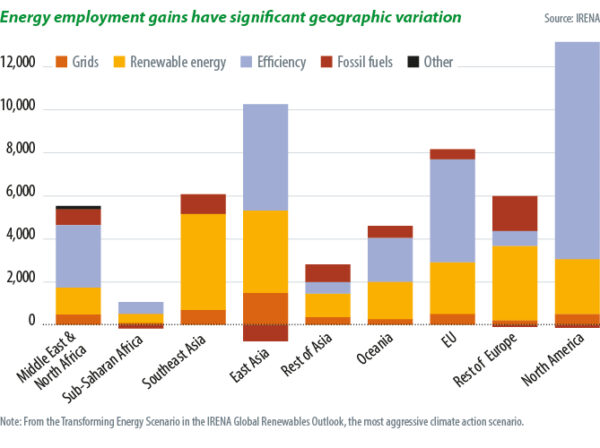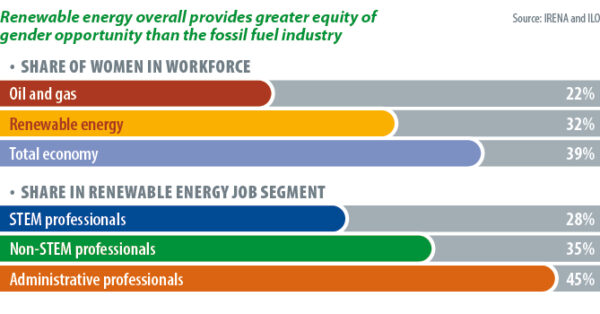Not all green jobs are created equal but they all address the equity dimension of a just transition. With women representing 32% of the clean energy workforce – more than the 21% present in the fossil fuel industry – there is hope of gender parity. But we need a shift from job quantity to quality and a new way of talking about green employment.
“Houston, we have a problem,” is how the energy transition was framed at the recent CERAWeek, the annual energy conference organized by US-based financial information company S&P Global. The words were uttered by Sultan Ahmed Al Jaber, CEO of the Abu Dhabi National Oil Company and president-designate of this year’s COP28 climate summit, to be held in the United Arab Emirates. That warning should resonate with a global economy that has reached peak oil.
It caused me to reflect on my move from big oil to the huge global potential of renewables as I attended CERAWeek for my second visit to Texas – arguably the world’s energy capital. My choice was less about leapfrogging the energy transition – the topic of my panel session on finance in emerging markets – and more about finding co-benefits instead of trade-offs in my search for regeneration.
CERAWeek is traditionally a tough crowd for energy transition messaging but recent analysis by sustainability research body the Rocky Mountain Institute (RMI) has spelled out the bare facts: The energy revolution is being televised. We either wake up to that reality now or, as climate change’s impacts intensify, we will soon find out we’re living in a nightmare.
While climate change can sometimes feel like watching “Titanic,” the energy transition is not a movie. And yet, as we’re coming out of Oscars season, it’s worth noting it took films such as “Hidden Figures,” and “The Boy That Harnessed The Wind” to shed light on the key role African-American women played in the moon landing and how a young boy from Malawi imagined a world independent of oil.
Jobs quandary
Industries such as solar, and fossil fuel-dependent communities may share frustrations. The latter might feel invisible against a relentless energy transition promising, sometimes unconvincingly, like-for-like green employment. Solar proponents may be frustrated those with science, technology, engineering, and mathematics skills crucial for the clean power sector continue to be attracted to better-paid jobs in extractive industries.
The first International Energy Agency report on energy employment revealed more than half of the world’s power sector jobs are now in clean energy but the last International Renewable Energy Agency-International Labour Organization study reported only 12.7 million renewables jobs – 4.3 million in solar. We need 30 million this decade for net zero in 2050.
Appreciating green jobs are not created equally is the first step to understanding the hidden costs to communities of fossil fuel job losses. Similarly, highlighting the benefits of a just transition that goes beyond employment leads to new conversations about true regeneration of fossil fuel-dependent communities. In “Titanic” terms, it took a few shipwrecks for humanity to wake up to the peril of icebergs and the RMI’s green jobs report (see graph below) takes a similar approach.

But where are the icebergs ahead of us? Are they in Asia or Africa? What is beyond doubt is the dwindling role of fossil fuels in the face of a fast-accelerating transition driving the need for a flexible, adaptive global workforce. To adapt in a just, equitable way to a new world and changing climate, the energy transition needs to go well beyond “job incrementality.”
Through a broader lens, it is possible to see this radical energy shift calls for better alignment with worker expectations and needs. As the world increasingly moves toward a sustainable, and even regenerative economy, new opportunities will emerge in the remediation of degraded natural resources, adapting to a changing climate, and building circular material pathways. We also need to go beyond “job inequality,” as workers can then contemplate non-quantitative aspects of fossil fuel compensation: where those jobs are, how long they will last, and what they will pay both now and in a future of oil, gas, and coal stranded assets.
In the Global South, there are structural barriers to community investment that need to be overcome through financial de-risking and technical capacity building, so we must also go beyond how many green jobs are created, to focus on who they are being created for. Following Women’s History Month, I was pleased to see the conversation in Houston increasingly led by women. They represent the population segment most likely to benefit from green jobs, as data shows (see below).

Initiatives including the RMI’s Energy Transition Academy and the Women In Renewable Energy Network offer opportunities to expand the support given to those taking a leap of faith away from fossil fuels. We must find ways to increase the share of women taking technical and managerial responsibility, so they are in the driving seat.
 About the author: Raul Alfaro-Pelico is senior director of the Global South program at the RMI. He leads policy advisory, thought leadership, capacity development, technical backstopping, and investment preparation support for a net-zero, resilient, and prosperous world. Alfaro-Pelico oversees the Africa Energy program, which enables energy access and de-risks clean energy projects, and the Energy Transition Academy, which empowers senior- and mid-level practitioners in the electricity, industrial, and financial sectors in the Global South.
About the author: Raul Alfaro-Pelico is senior director of the Global South program at the RMI. He leads policy advisory, thought leadership, capacity development, technical backstopping, and investment preparation support for a net-zero, resilient, and prosperous world. Alfaro-Pelico oversees the Africa Energy program, which enables energy access and de-risks clean energy projects, and the Energy Transition Academy, which empowers senior- and mid-level practitioners in the electricity, industrial, and financial sectors in the Global South.
The views and opinions expressed in this article are the author’s own, and do not necessarily reflect those held by pv magazine.
This content is protected by copyright and may not be reused. If you want to cooperate with us and would like to reuse some of our content, please contact: editors@pv-magazine.com.



1 comment
By submitting this form you agree to pv magazine using your data for the purposes of publishing your comment.
Your personal data will only be disclosed or otherwise transmitted to third parties for the purposes of spam filtering or if this is necessary for technical maintenance of the website. Any other transfer to third parties will not take place unless this is justified on the basis of applicable data protection regulations or if pv magazine is legally obliged to do so.
You may revoke this consent at any time with effect for the future, in which case your personal data will be deleted immediately. Otherwise, your data will be deleted if pv magazine has processed your request or the purpose of data storage is fulfilled.
Further information on data privacy can be found in our Data Protection Policy.